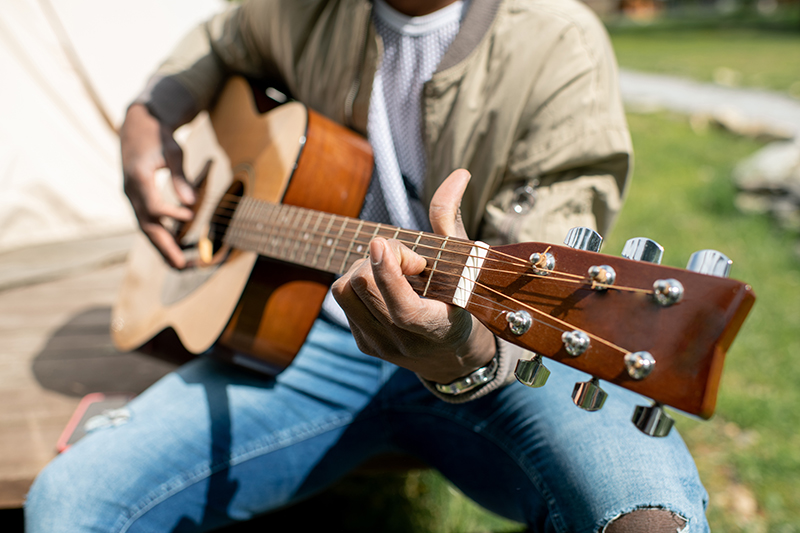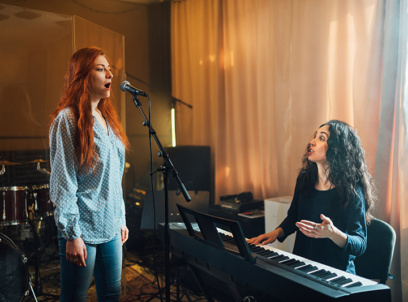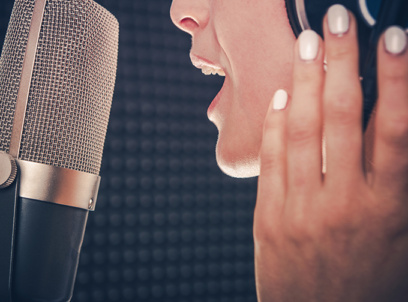The 8 Open Guitar Chords For Beginners
Learning guitar can be tricky, and it can be very confusing on where you should begin.
When I first learned guitar, i started simply by learning what are called ‘Open Chords’
These chords translate to both Acoustic & Electric Guitars and are an excellent place to start.
When you partner these chords with an easy strum pattern and some simple songs, you are set!
The easiest advice we like to give beginners is begin with songs that you know and love, but if you are new to playing music and don’t know much about chording and theory, songs like ‘She Will Be Loved’ (Maroon 5), ‘With or Without You’ (U2), ‘Hey Jude’ (The Beatles), and ‘Africa’ (Toto) are classics and incredible songs to start with.
We are going to show you how to play these chords step by step, where to put your fingers and how to place your fingers on the strings.
The numbers on the dots in the chord diagrams above indicate the finger positioning:
1 = index finger, 2 = middle finger, 3 = ring finger, 4 = pinky
C Major Chords
The C major chord is played with your index (first) finger on the 2nd string (B-string) on the first fret.
Your second finger (middle finger) on the 4th string (D-string) on the second fret.
And finally your third finger (ring finger) on the 5th string (A-string) third fret.
The 6th string is muted (see X above 6th string), so only hit the lower 5 strings with the strumming hand.
The little ‘o’ on top of the G and high E-string means these are ‘open strings’.
The notes of the C major chord are: C – E – G (first, third and fifth notes of the C major scale).
A Major Chord
The A major chord is played with your first (index) finger on the 4th string (D-string) on the second fret.
Your second finger (middle finger) on the 3rd string (G-string) on the second fret.
And finally your third finger (ring finger) on the 2nd string (B-string) second fret.
The 6th string is muted (see X above 6th string), so only hit the lower 5 strings with the strumming hand.
The little ‘o’ on top of the A and high E-string means these are ‘open strings’.
The notes of the A major chord are: A – C# – D (first, third and fifth notes of the A major scale).
The G major chord starts with your first (index) finger on the 5th string (A-string) on the second fret.
Your second finger (middle finger) on the 6th string (low E-string) on the third fret.
Your third finger (ring finger) on the 6th string (high e-string) third fret.
The little ‘o’ on top of the D G and B-string means these are ‘open strings’.
You can strum all the strings with your strumming hand. No strings are muted.
The notes of the G major chord are: G – B – D (first, third and fifth notes of the G major scale).
E Major Chord
The E major chord starts with your first (index) finger on the 3rd string (G-string) on the first fret.
Your second finger (middle finger) on the 5th string (A-string) on the second fret.
And your third finger (ring finger) on the 4th string (D-string) third fret.
The little ‘o’ on top of the Low E string and B and high e-string means they are ‘open strings’.
You can strum all the strings with your strumming hand. No strings are muted.
The notes of the E major chord are: E – G# – B (first, third and fifth notes of the E major scale).
D Major Chord
The D major chord is played starting with your first (index) finger on the 3rd string (G-string) on the second fret.
Your second finger (middle finger) on the 1st string (high e-string) on the second fret.
And finally your third finger (ring finger) on the 2nd string (B-string) third fret.
The 5th and 6th string are muted (see X’s), so only hit the lower 4 strings with the strumming hand.
The little ‘o’ on top of the D-string means it’s an ‘open string’.
The notes of the D major chord are: D – F# – A (first, third and fifth notes of the D major scale).
E minor Chord
The Em (E minor) chord starts with your second (middle) finger on the 5th string (A-string) on the second fret.
And your third finger (ring finger) on the 4th string (D-string) on the second fret.
The little ‘o’ on top of the Low E, G, B and high e-string means these are ‘open strings’.
You can strum all the strings with your strumming hand. No strings are muted.
The notes of the E minor chord are: E – G – B (first, flattened third and fifth notes of the E major scale).
A minor Chord
The Am (A minor) chord starts with your first (index) finger on the 2nd string (B-string) on the first fret.
Your second finger (middle finger) on the 4th string (D-string) second fret.
And your third finger (ring finger) on the 3rd string (G-string) second fret.
The little ‘o’ on top of the A and high e-string means these are ‘open strings’.
The 6th string is muted (see X above 6th string), so only hit the lower 5 strings with the strumming hand.
The notes of the A minor chord are: A – C – E (first, flattened third and fifth notes of the A major scale).
D minor Chord
The Dm (D minor) chord starts with your first (index) finger on the 1st string (high e-string) on the first fret.
Your second finger (middle finger) on the 3rd string (G-string) second fret.
And your third finger (ring finger) on the 2nd string (B-string) third fret.
The little ‘o’ on top of the D-string means it’s an ‘open string’.
The 5th and 6th string are muted (see X above 6th string), only hit the lower 4 strings with the strumming hand.
The notes of the D minor chord are: D – F – A (first, flattened third and fifth notes of the D major scale).
Again, the best way to learn these chords is to apply them to songs that you enjoy listening to and songs that already inspire and move you.
Start with three chord songs to begin with, and then later, when you have the hang of playing and switching between chords, you can try some four chord songs.
Beginner Tips
– Press the strings with the very tips of your fingers.
– Bend all three knuckles.
– Make sure your fingers are as close to the fret as possible.
– If you press a string make sure your finger isn’t touching and muting the string below.
– Rest your thumb on the back of the guitar neck, not on top of it.
– Start practicing three chords songs (G – C – D). and later four chord songs.
– Practice doesn’t make perfect, but it does make you better….So practice daily!
Happy playing, creating, and worshipping!
James Goddard
Worship Academy



